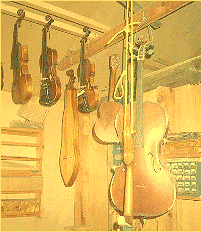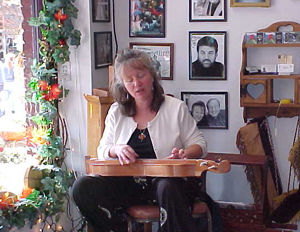|
Click here for Next Section |

A Country Rag Rivers Side
|
By Susan Lachmann
In a region providing many varieties of hardwoods, the instrument’s popularity continues to be built on cherry, curly maple, wormy chestnut, walnut, red cedar, spruce, and sassafras just to name a few. Like most wood instruments, its tone quality improves with age and use, with each type of wood having it’s own particular effect on the sound as well as variation in color and grain. The classic teardrop and figure eight shapes traditionally hold three, four or five strings, tuned in octaves with a fifth to create drones, giving it an ancient, modal sound. The 22”-26” box with fret board, approximately two inches deep, is played by strumming with the right hand and using a “noter” (approximately three inches in length, one-quarter inch in diameter) in the left hand. While some players prefer to use a pick, others use fingers on the strings.
Another nice thing about the dulcimer is that it is really quite simple to play. Here’s how it works. First: sit down and get comfortable. Next, rest the instrument across your lap, tuning pegs at the left hand. Then, start strumming with the right hand, down by the bridge. Presto! Instant harmony! Make melodic changes by pressing the noter on the string(s) against the fret board, sliding it up and down the frets, leaving the other strings open for the drone sound. Typically, on a three stringed dulcimer, the top string is used to play melody while the bottom two are drones. On a four stringed dulcimer, there is one melody string and three drones. The melody is doubled on the top two strings of a five stringed dulcimer, with the bottom three as drones. All you have to do is spend a little time with it, and you will easily surrender to the sweet sound.
I first “met” the lap dulcimer in Kentucky, where there seem to be the strongest roots for this folk instrument. Homer Ledford, a master craftsman and musician near Lexington, welcomed me into his workshop for a chance to see and play his handiwork. It was mesmerizing, the maze of woods and sounds, and his reputation for kindliness played out during the visit. Now in his mid-seventies, Ledford is still considered one of
the finest builders in the country. He continues to perform with friends and family for traditional and bluegrass festivals and has a quiet, unassuming yet endearing persona.
Another Kentuckian, John Jacob Niles, brought his unique style to the Lexington area. As noted collector, composer and publisher of mountain songs, Niles’ works remain a significant resource for musicologists and performing musicians. I remember well his concert at the Lexington Opera House, where I was among the audience in the late 1970’s. It was a fantastic display of instruments, some traditional builds and some his own variations, as well as his captivating, dramatic vocal style. “Hangman, hangman, slack your line,” he sang in baritone or soprano depending on the character, “I think I see my Father comin, traveling many a mile, traveling many a mile.” Strums from the dulcimer were sometimes rapid and erratic, other times smooth and quiet according to his interpretations. Mr. Niles was an eccentric; he created sound context for continuing interest in the tradition of mountain music.
Just a little way from Jonesborough, where A Country Rag is published, is the home and workshop of Robert R. Mize in Blountville, Tennessee. Quiet and unassuming, as dulcimer players often seem to be, Mr. Mize and his family members have been crafting handmade dulcimers for decades. When the time came for me to find my own dulcimer, the search led me to his workshop. Never had I seen such varieties in wood, indeed I did not even know they existed! Birds eye maple, curly maple, andaroba, butternut - he brought out the pieces one by one, brushed them up with just a stroke or two of some solution to highlight the grain. Wormy chestnut, sassafras, walnut…the richness of each color and grain made choosing a difficult task. When I had finally narrowed it down to either wormy chestnut top with a walnut back or all andaroba, he said he’d just make both. Every wood has its own tone he told me, so I could choose by the sound once they were made. What a generous gesture from this big hearted artist and craftsman who clearly knew how important it was for a musician to find the right instrument. I chose the andaroba and have never thought to make a change, for the beauty of the book matched back and solid top is equal to the rich and pleasing tone. The dulcimer is simple and sweet and a joy to play.
Whereas it was once unusual to see, today the dulcimer is common among bluegrass bands and contemporary folk performers. You’ll find some interesting adaptations these days, with shoulder straps for playing while standing, or portable stands for band stage performance. There are even dulcimers with built in hook ups for electric amplification. My favorite way to play, though, is just to sit and share the sound in a small venue, an intimate setting for friends or on my own back porch for myself. It is highly accessible and satisfying, a great source of relaxation and comfort. Here’s hoping you, too, will find your way to the sweet sound of the mountain dulcimer.
|
|
Graphic: photo, Susan Lachmann (Sound Learning) playing dulcimer at Cranberry Thistle  |
|
Questions? Comments? Email A Country Rag.
|
text c. Susan Lachmann, graphics c. Jeannette Harris; July 2001. All rights reserved.
|
Click here for Next Section (Rustic Refrain) |
